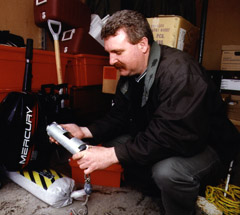 |
When it comes to the lives of shellfish, Lewis knows all the ins
and outs. As a government extension officer, he passes along that
knowledge to shellfish farmers, free of charge. And that's helping
Nova Scotia's growing aquaculture industry stay healthy. Two to
four weeks after shellfish spawn, they look for a place to 'set',
where they'll grow for the rest of their lives. One of the keys
to aquaculture success is to know when a set is going to happen.
Lewis is an expert. By towing a fine net through an aquaculture
site and looking through a microscope at the soup of micro-organisms
he's picked up, he can tell farmers the optimal time to put out
rocks or ropes for the shellfish to set on. If the gear gets into
the water too early, it will foul up, and the shellfish won't set.
If it's in too late, they'll set elsewhere.
"It's important to know when that set is going
to happen and it can vary depending on things like water temperature.
We can narrow it down to within four or five days," Lewis says.
"That takes up a fair amount of our season, really, because mussels
spawn on the South Shore as early as May or June, but not on the
Eastern Shore until maybe August. And oysters usually spawn in
June, so you have a lot of ground to cover."
Once spawning season is over, he gets called
out to shellfish farms to deal with crises. He may have to help
diagnose the cause of an unexpected die-off, for example.
Another of his responsibilities is to visit potential
aquaculture sites, to test water salinity, temperature and other
factors, and help future shellfish farmers assess the viability
of their chosen spot.
Good people
skills are essential, Lewis says. "You can't go in and say, 'I'm
from the government and here's what you have to do.'"
|
 |


